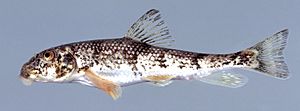Roanoke hogsucker facts for kids
Quick facts for kids Roanoke hogsucker |
|
|---|---|
 |
|
| Conservation status | |
| Scientific classification |
The Roanoke hogsucker (Hypentelium roanokense) is a type of freshwater fish. It lives in the upper and middle parts of the Roanoke River in North Carolina and Virginia. This fish is part of the sucker family, called Catostomidae. It looks a lot like another fish, the northern hogsucker, and they often live in the same places. People who like to fish sometimes enjoy catching Roanoke hogsuckers because they put up a good fight. However, they are not considered a "game fish" and are quite rare because they don't live in many places.
Contents
What it Looks Like
The Roanoke hogsucker can grow up to about 16 centimeters (about 6 inches) long. It has a body shape similar to other hogsuckers. This includes a boxy head, lips that stick out, and dark patches on its back.
It's easy to confuse the Roanoke hogsucker with the northern hogsucker. But you can tell them apart in four ways:
- It has light lines that go across its back and sides.
- The dark patches between its head and dorsal fin (the fin on its back) are not very clear.
- It has 41 scales along its lateral line (a special line of scales on its side).
- It has 31 rays in its pectoral fins (the fins on its chest).
Where it Lives and Its Home
The Roanoke hogsucker naturally lives in the Dan River area. This area is part of the upper and middle Roanoke River Basin in North Carolina and Virginia.
Sometimes, these fish have been found in small streams that flow into the Yadkin-Pee Dee River system. However, scientists think they were put there by people using them as bait.
The Roanoke hogsucker can live in many different types of water. It usually stays near the bottom of rivers and streams. You can find it in both cool and warm streams. It lives in fast-moving, rocky streams as well as calm, sandy pools.
What it Eats
The Roanoke hogsucker mostly eats small crustaceans, which are like tiny crabs or shrimp. It also eats insect larvae, especially fly larvae. Sometimes, it will eat plants that grow on rocks.
How it Behaves
Life Cycle and Reproduction
Scientists have not fully studied the life cycle and reproduction of the Roanoke hogsucker. Male fish are ready to have babies after one or two years. They usually live for about four years. Female fish are ready to have babies when they are three years old. They typically live for about five years.
Spawning (when they lay eggs) happens in early to mid-spring. We don't know much about how they find mates or lay their eggs.
Human Connection
The Roanoke hogsucker is often found in the same places as bass, which are popular sport fish. However, the hogsucker itself is not considered a "game fish."
The North Carolina Natural Heritage Program calls this fish "significantly rare." This is because it only lives in a small area. The Roanoke hogsucker does not pose any danger to humans. The only risk might be if a fish darts away quickly and causes an angler to slip.
The populations of Roanoke hogsuckers are not in immediate danger. But they could be harmed quickly if their homes are not protected from human damage.
See also
 In Spanish: Hypentelium roanokense para niños
In Spanish: Hypentelium roanokense para niños


